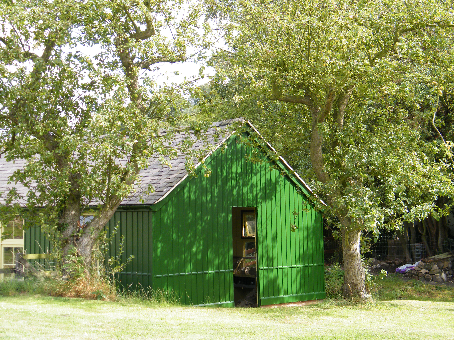The site museum
Following Sir William St.John Hope’s excavations in 1878 and 1879, the then landowner, Earl Stanhope, determined to build a site museum to protect and to store some of Hope’s finds. The ‘green hut’ thus created was one of the first site-museums in the country and, as such, it is included, with ‘the arch’ and footings, in the schedule of the ancient monument.
It is a timber structure, slate roofed, and now appears to have been repaired twice, once in the 1930’s and the second time in 2009. (You can see the condition it had reached on the Restoration pages.) Its problem has always been rotting from the base up despite, in the 1930’s, the addition of a damp-proof membrane. Some further minor changes were made in 2009 to mitigate this problem. We can only hope they will be effective!
The hut is built within the footings of the Chapter House, and it’s bit of a shock when you go through the door, because there, in front of you, are the steps that once led from the cloister to the Chapter House, and a number of graves, mostly as Hope left them. The most spectacular however was given a plinth, probably in the 1950’s or 60’s, because it boasts a polythene damp-proof course. On shelves around the walls were the floor tiles that Hope had removed for safe-keeping. Unfortunately over the years a multitude of visitors has concluded that if they took just one tile as a keepsake it wouldn’t matter, with the result that (1) those that are left are generally not in good condition (2) we’ve had to add steel grilles to keep them where they should be. The grilles don’t improve the appearance.
The hut is built within the footings of the Chapter House, and it’s bit of a shock when you go through the door, because there, in front of you, are the steps that once led from the cloister to the Chapter House, and a number of graves, mostly as Hope left them. The most spectacular however was given a plinth, probably in the 1950’s or 60’s, because it boasts a polythene damp-
